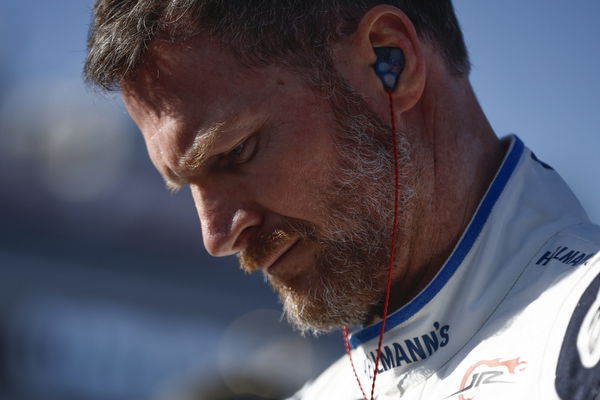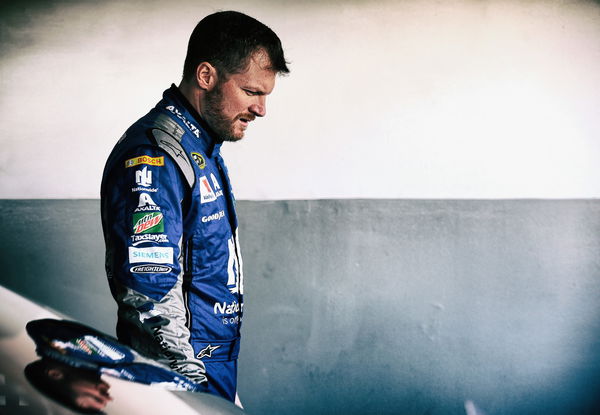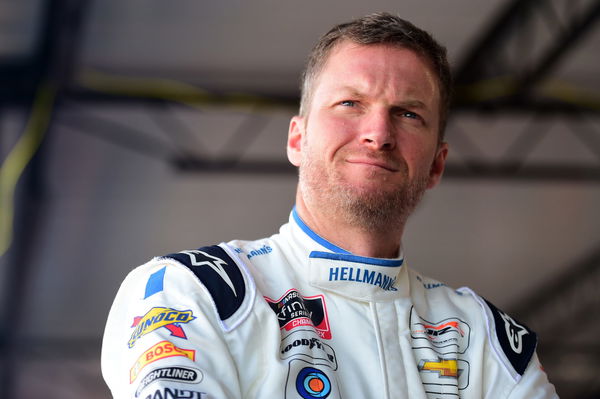Dale Earnhardt Jr Gets 20-Year-Old NASCAR Winner’s Support for “Band-Aid” Solution

Follow Us

via Imago
Dale Earnhardt Jr & Denny Hamlin I Image Credits: Imago
After a scorching weekend at Richmond Raceway, the NASCAR community has been buzzing with discussions on how to enhance short-track racing. Dale Earnhardt Jr, a revered figure in the sport, sparked a conversation on Twitter suggesting the use of resin in the higher racing lanes at Richmond. Seeing this, Denny Hamlin of JGR raised concerns, hinting at underlying issues that may require more comprehensive solutions.
As the racing world contemplates the best way forward, the debate centers around the effectiveness of the proposed resin fix and the need for aerodynamic changes or tire modifications to enhance safety and competitiveness. However, this “band-aid” solution aimed to improve racing quality has drawn support from none other than a young, talented driver.
Resin as a Magical Band-Aid for Richmond Raceway’s
ADVERTISEMENT
Article continues below this ad
As the sun dipped below the horizon, casting a golden glow over the Richmond Raceway after a weekend of intense racing, we got a special guest on the podcast “Door Bumper Clear,” Carson Hocevar, a 20-year-old rising star who added another win to his tally. The studio was abuzz with energy as TJ Majors, Brett Griffin, and Andrew Kurland welcomed the young driver, eager to hear his perspective. Amidst various topics of discussion, the use of resin at Richmond Raceway took center stage. Carson expressed genuine curiosity about the effects of resin on the track.
Leaning in, he shared his thoughts, “I’m curious what resin would do to the race track. I think resin makes Nashville really really good race track. And I like how the rubber gets added. Like I feel like the resin adds a lot of rubber to the racetrack like Richmond never really rubbers up.” He acknowledged the importance of tire wear and the significance of rubber build-up on the track to facilitate multiple racing lines.
With a little more rubber on Richmond’s surface, drivers would have the opportunity to explore different lines, creating side-by-side battles and increasing the excitement for both fans and racers. Despite seeing brief moments of side-by-side racing at Richmond, Hocevar believes a bit more rubber could enhance competition and make the short-track races more captivating. He emphasized, “the paint still going to be the fastest because it’s a shortest you have the grip on there right but it allows a little bit of move around.”
As the conversation flowed, it became evident that Carson supported Dale Jr’s resin idea, not just as a band-aid solution, but as a step towards bringing back the thrill and unpredictability of short-track racing.
Watch The Story: Dale Earnhardt Jr Delivers Bad News To Chase Elliott With Playoff Verdict
The ‘Lift Splitter’ Debate: Balancing Downforce and Tire Wear Challenges for Short-Track Racing
ADVERTISEMENT
Article continues below this ad
Trending

Dale Earnhardt Jr’s Step Mother Plotting Mind Games Against the Earnhardt’s As DEI Resurfaces Over Disputes
May 13, 2024 07:09 AM EDT

Denny Hamlin Pushes the Blame on Notorious Brad Keselowski as He Acquits His Driver From Foul Play
May 14, 2024 10:02 AM EDT

Dale Earnhardt Jr’s Petty Step-Mother Allegedly Goes One Step Further to Reignite Feud With Former Nemesis
May 13, 2024 07:20 AM EDT

Stewart-Haas Racing’s Driver Addresses Exit Rumors After Season Best Performance at Darlington
May 13, 2024 10:26 AM EDT

Underage Driver Wrecking Dale Earnhardt Jr’s CARS Tour Star Triggers Age Limit Debate Among NASCAR Fans
May 13, 2024 02:39 PM EDT
Get instantly notified of the hottest NASCAR stories via Google! Click on Follow Us and Tap the Blue Star.

Follow Us
NASCAR’s recent announcement of testing a ‘lift splitter’ to improve short-track races has sparked a debate within the racing community. The goal is to create lift in clear air and downforce in traffic, making it easier for cars to follow each other closely. However, Denny Hamlin, a seasoned driver, has expressed skepticism about the potential effectiveness of splitters in addressing the challenges faced on short tracks.
Hamlin’s main concern lies in the absence of tire fall on short tracks. He believes that for splitters to work optimally, the cars need to wear out the tires, requiring either increased downforce or significantly softer tires. Currently, NASCAR cars have the lowest levels of downforce since the 90s, and adding a splitter would reduce it even further. This could lead to less overall grip, forcing the need for additional mechanical grip, thereby altering the racing dynamics.
In agreement with Hamlin’s views, Jared Allen reiterated that splitters might not be a complete solution since they may lift the front runners off the ground but do little to accelerate tire wear. Moreover, the consequence would be less tire rubber on the track, potentially limiting the drivers’ ability to explore different lines and engage in exciting overtaking maneuvers.
ADVERTISEMENT
Article continues below this ad
The NASCAR community finds itself at a crossroads, contemplating the best approach to enhance short-track racing. Could this simple “band-aid” fix be the key to unlocking the adrenaline-pumping battles at Richmond and beyond? As the sport evolves, the enthusiasm of these rising stars and the backing of seasoned veterans signal a promising future for short-track racing in NASCAR. The question remains – will this bold idea lead to a captivating transformation of the tracks, ushering in a new era of racing excitement?
Edited by:
Ranvijay Singh


